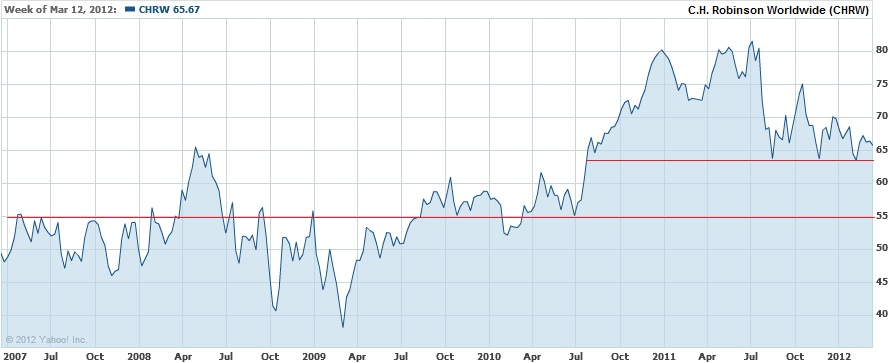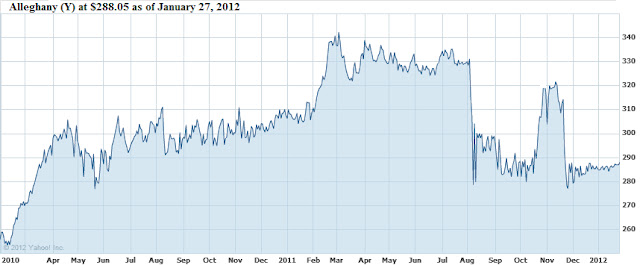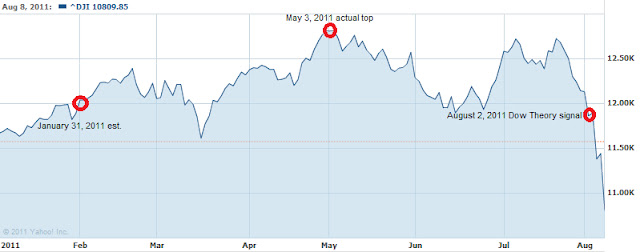Below are the Nasdaq 100 companies that are within 20% of their respective 52-week lows. This Nasdaq 100 Watch List is strictly for the purpose of researching whether or not the companies have viable business models or are about to go out of business. These companies are deemed highly speculative unless otherwise noted.
|
Symbol
|
Company | Price | P/E | EPS | Yield | P/B | % from Low |
| FSLR | First Solar, Inc. | $26.11 | 0 | -0.46 | 0 | 0.64 | 3.24% |
| CHRW | C.H. Robinson Worldwide | $64.42 | 24.59 | 2.62 | 2 | 8.44 | 3.40% |
| CTRP | Ctrip.com Int'l | $22.83 | 20.37 | 1.12 | 0 | 2.93 | 3.68% |
| EA | Electronic Arts Inc. | $16.86 | 0 | -0.52 | 0 | 2.49 | 5.05% |
| RIMM | Research In Motion | $13.66 | 3.22 | 4.25 | 0 | 0.7 | 9.72% |
| VOD | Vodafone Group Plc | $27.65 | 12.74 | 2.17 | 3.4% | 1.07 | 13.74% |
| APOL | Apollo Group, Inc. | $42.41 | 12.02 | 3.53 | 0 | 4.1 | 14.37% |
| ORCL | Oracle Corporation | $28.55 | 14.96 | 1.91 | 0.8% | 3.31 | 15.49% |
| SRCL | Stericycle, Inc. | $84.66 | 31.47 | 2.69 | 0 | 6.04 | 15.89% |
| AMZN | Amazon.com, Inc. | $195.04 | 142.36 | 1.37 | 0 | 11.29 | 16.81% |
| VMED | Virgin Media Inc. | $23.98 | 63.95 | 0.38 | 0.7% | 6.82 | 16.86% |
Watch List Summary
Because we’re still in a bear market and have had significant divergence between the Dow Industrials and the Dow Transports index, we believe there could be significant downside action in the near term. With this in mind, our first stock of interest is Oracle Corporation (ORCL). While the stock is slightly more than 15% above the 1-year low, it is necessary to plan your next purchase of this stock.
When viewed from a Dow Theory perspective, the following are the downside targets from the current price:
-
$25.48 (fair value)
-
$21.82
-
$14.48
The low of December 2011 is the exact level of ORCL’s fair value based on Dow Theory. If Oracle were to fall below the December 2011 low the next downside target is $21.82. We wouldn’t put it past Oracle to decline to $14.48, however, a 3-part purchase plan with the first at $25.28 would be reasonable. If you have $10,000 to invest in ORCL then we’d arrange the purchased in the following order:
-
1st-$5,000 at $25.48
-
2nd-$3,500 at $21.82
-
3rd-$1,500 at $14.48
The next stock that we’re considering is Stericycle (SRCL). Stericycle first appeared on our October 17, 2009 Nasdaq 100 Watch List. At the time, Stericycle was trading at $52.12. Since then, SRCL has soared as high as $95.71 on an intra-day basis, a gain of 83.63%. Don’t be fooled by the fact the Stericycle sports a “high” price relative to the $52 level. The point of a stock approaching a new low is that it transmits new information on the relative value.
According to Dow Theory, Stericycle has the following downside targets:
-
$79.39
-
$71.23 (fair value)
-
$63.07
-
$46.75
We’d structure the purchase of Stericycle (SRCL) into two steps. The first purchase at $71.23 (or lower) with 75% of the intended amount and the second purchase at $63.07 (or lower) with the remaining funds.













